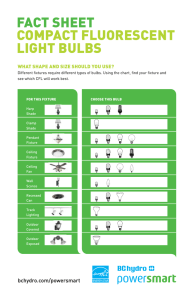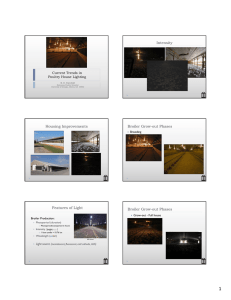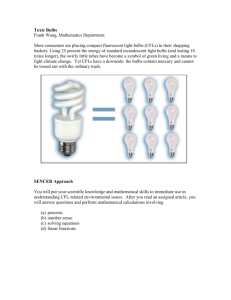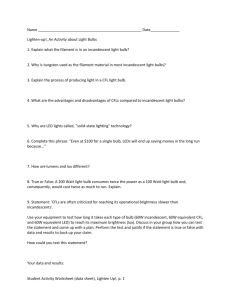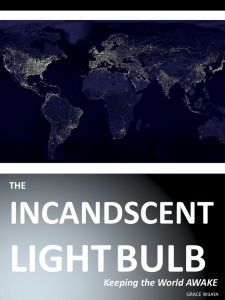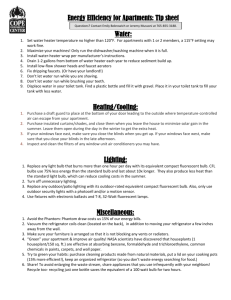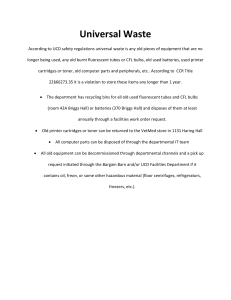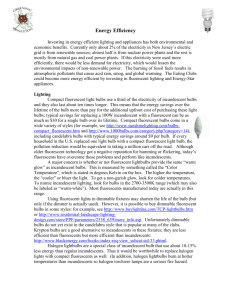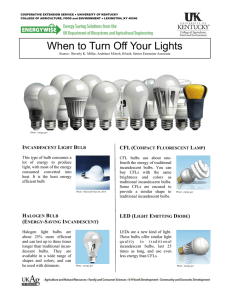Light Bulb Activity
advertisement
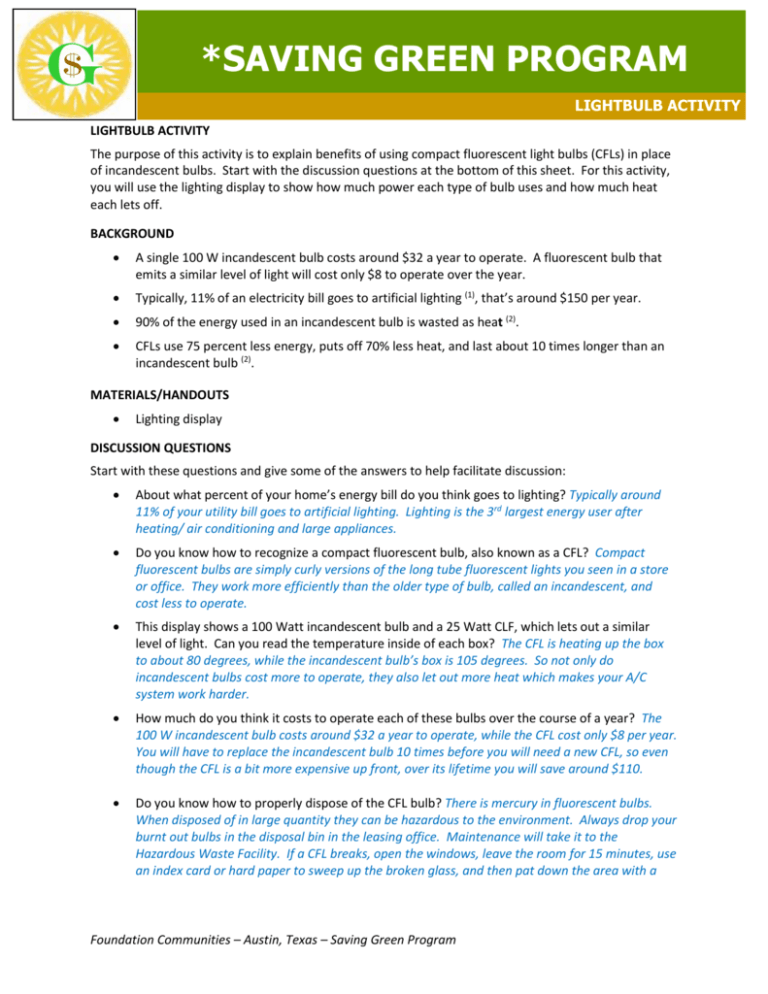
$ G *SAVING GREEN PROGRAM LIGHTBULB ACTIVITY LIGHTBULB ACTIVITY The purpose of this activity is to explain benefits of using compact fluorescent light bulbs (CFLs) in place of incandescent bulbs. Start with the discussion questions at the bottom of this sheet. For this activity, you will use the lighting display to show how much power each type of bulb uses and how much heat each lets off. BACKGROUND A single 100 W incandescent bulb costs around $32 a year to operate. A fluorescent bulb that emits a similar level of light will cost only $8 to operate over the year. Typically, 11% of an electricity bill goes to artificial lighting (1), that’s around $150 per year. 90% of the energy used in an incandescent bulb is wasted as heat (2). CFLs use 75 percent less energy, puts off 70% less heat, and last about 10 times longer than an incandescent bulb (2). MATERIALS/HANDOUTS Lighting display DISCUSSION QUESTIONS Start with these questions and give some of the answers to help facilitate discussion: About what percent of your home’s energy bill do you think goes to lighting? Typically around 11% of your utility bill goes to artificial lighting. Lighting is the 3rd largest energy user after heating/ air conditioning and large appliances. Do you know how to recognize a compact fluorescent bulb, also known as a CFL? Compact fluorescent bulbs are simply curly versions of the long tube fluorescent lights you seen in a store or office. They work more efficiently than the older type of bulb, called an incandescent, and cost less to operate. This display shows a 100 Watt incandescent bulb and a 25 Watt CLF, which lets out a similar level of light. Can you read the temperature inside of each box? The CFL is heating up the box to about 80 degrees, while the incandescent bulb’s box is 105 degrees. So not only do incandescent bulbs cost more to operate, they also let out more heat which makes your A/C system work harder. How much do you think it costs to operate each of these bulbs over the course of a year? The 100 W incandescent bulb costs around $32 a year to operate, while the CFL cost only $8 per year. You will have to replace the incandescent bulb 10 times before you will need a new CFL, so even though the CFL is a bit more expensive up front, over its lifetime you will save around $110. Do you know how to properly dispose of the CFL bulb? There is mercury in fluorescent bulbs. When disposed of in large quantity they can be hazardous to the environment. Always drop your burnt out bulbs in the disposal bin in the leasing office. Maintenance will take it to the Hazardous Waste Facility. If a CFL breaks, open the windows, leave the room for 15 minutes, use an index card or hard paper to sweep up the broken glass, and then pat down the area with a Foundation Communities – Austin, Texas – Saving Green Program $ G *SAVING GREEN PROGRAM LIGHTBULB ACTIVITY wet paper towel(3). Put everything, including the clean up material, in a sealable plastic bag and take it out to the trash bin. RESOURCES (1) U.S. Department of Energy, 2007 Buildings Energy Data Book, 2005 energy cost data (2) US Department of Energy, Energy Efficiency and Renewable Energy www.energysavers.gov/your_home/lighting_daylighting/index.cfm/mytopic=11970 (3) CFL Fact Sheet, Connecticut Department of Public Health http://www.ct.gov/dph/lib/dph/cfl_fact_sheet_final.pdf (4) Austin Energy, Customer Electricity Rates http://www.austinenergy.com/About%20Us/Rates/residential.htm ***THIS ACTIVITY WAS CREATED AND GENEROUSLY SHARED WITH US BY FOUNDATION COMMUNITIES (AUSTIN, TEXAS) “SAVING GREEN” PROGRAM, a product of an ENTERPRISE SUSTAINABILITY TRAINING GRANT *** http://www.foundcom.org/about-us/green-building/ Foundation Communities – Austin, Texas – Saving Green Program


